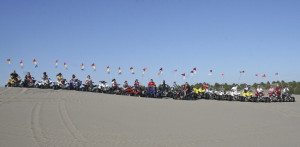Off-roading provides family adventure outlet
Adventure seekers ride growing boom, add to economy
The Phillips family is a bit scattered. Like many households, the kids grew up and moved out to start families of their own, leaving the comforts of Oregon for homes in California and Washington.
“We love our kids and grandkids so much, but with everyone all over the place it can be a bit tough to connect beyond phone calls and emails,” said family patriarch Jody Phillips. “That’s why we’ve made the commitment to take a collective vacation together every year.”
Unlike many families though, the Phillips’ don’t take a cruise or go to the beach when they get together. They love the sand, they just prefer to ride over it on their ATVs, rather than build castles and a good tan.
“We’re all avid fans of off-roading, and have found that riding together is an exciting and fun way to spend some time with each other,” Phillips said.
“Kids spend way too much time in front of a TV or an iPhone,” he added. “When we get together, all that goes away, and we spend 100 percent quality time. We teach them not only how to have a great time, but how to love and respect the land.”
It seems they’re not alone in that sentiment either, as the off-roading community continues to show growth despite the state of the economy. Studies by Southwick Associates on behalf of the Outdoor Industry Association, estimate that enthusiasts spent close to
$66.5 billion on the activity last year, which supports nearly 700,000 jobs and generates $8.5 billion in federal, state and local taxes.
“A lot of people used to think that off-road recreation was a luxury activity that required a certain level of income to do,” said Greg Mumm, executive director of The BlueRibbon Coalition, a national group of organizations, businesses and individuals working to protect and expand outdoor recreation access for the public. “That’s not really the case anymore, as equipment has become more affordable and individuals are able to determine their level of involvement based on how much they want to spend.”
The most basic forms of off-roading can be done with pickup trucks, Jeeps, or ATVs, where a spare tire, a winch and a couple of other small safety tools are the only things needed to venture down dirt, gravel or sandy trails in designated public and private parks around the country.

The activity is done in virtually every state in the country, and has become a popular form of family entertainment. When the Phillips family gets together each July, they not only ride up and down the dunes, but usually end up sitting around a bonfire and do some crabbing in the ocean.
“Often the terrain of a trail system, whether on public land or in a private park, lends itself perfectly for competitions like the King of the Hammers off-road race in the deserts of southern California or the rock crawling events like the Easter Jeep Safari in Utah,” Mumm said. “That’s one of the best things about off-roading. There’s such a wide variety of things to do and see.”
“Ever since Arthur Warn developed the first recreational winch in 1959, we’ve been involved in the sport,” said Brendan Anderson, the vice president of marketing for Warn Industries, the world’s leading winch manufacturer. “Most of our employees are active riders, and we take pride in helping people safely participate in off-roading.”
Beyond safety equipment, responsibility and protection of the land are also great factors when it comes to taking vehicles off-road. The environment and ecosystem on all public and private lands is very fragile, and enthusiasts are encouraged to stay on all marked trails, keep an eye out for wildlife and repair any damage done to the land.
“The more irresponsible and careless people are when it comes to nature, the more difficult it becomes to justify why land access for off-roading is so important,” Mumm said. “If we’re proactive with trail maintenance and restoration programs, it ensures a better riding experience for everyone involved and goes a long way towards keeping those areas open for future use.”
As off-road recreation continues to increase in popularity, advocates active in their local communities are pushing to expand the amount of land open to the public. At the same time, environmental groups often seek tighter restrictions, fearing that the land will be damaged by off-roading.
“There’s got to be a meeting of the minds at some point,” Phillips said. “My family and a lot of others need to have lands available to them to enjoy this lifestyle. But we understand that carries the responsibility of making sure the land is protected. I think both sides in this want the same thing, but have trouble looking at it in the same way.”








